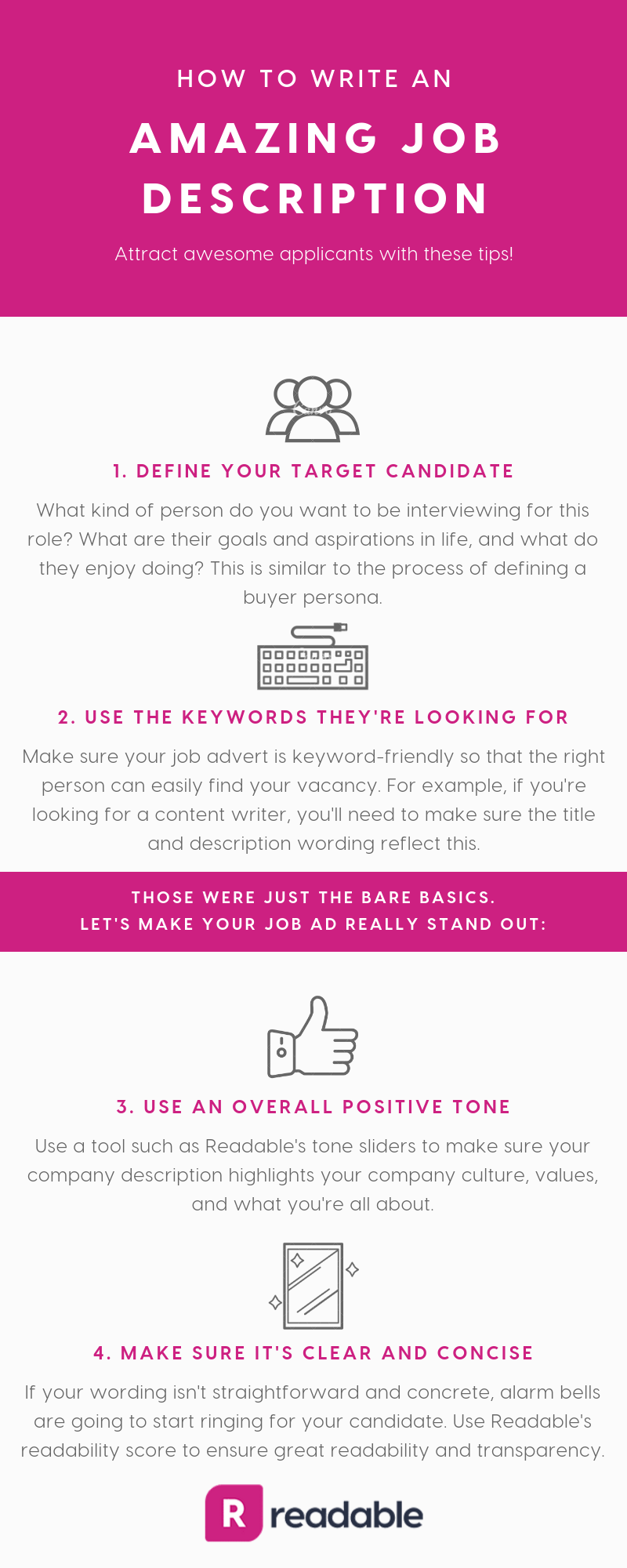Finding the right candidate for a job requires writing a stand-out job description that will cut through the noise. How can you make yours stand out from the crowd?
1 | Take the time to consider your target candidate
It’s amazing how similar writing a job description is to writing any kind of copy. If you were selling a product, you’d consider the kind of person you’re marketing it for. In this case, you’re selling a job.
Ultimately, you want to make sure your job advert is as efficient as possible in finding the right fit. This way, you spend less money and resources flicking through resumes and interviewing until you find them.
This means you need to have a really good think about the kind of person you want for this role. Not just their previous jobs and level of experience, but what goals and aspirations they have and what they enjoy doing.
This is similar to developing a buyer persona in marketing. It’s a truth widely acknowledged in marketing that we buy based on emotions and rationalize them later. So, what emotions do you want to tap into? What makes your ideal candidate happy?
What makes your ideal candidate happy?
If, for example, you have a really supportive and well-structured training programme, this will suit someone who is keen to progress, and enjoys learning in that style. It may not be suitable for someone who prefers to learn in their own way and responds better to a different management style.
Everyone is different, but it helps to know the types of workplace personalities you want to target with your job description. Is your priority to have a self-starter who can manage their own time or someone who above all is a team player?
When considering your candidate persona, be careful with demographics - there’s still a big problem with discrimination such as sexism, ageism and racism in recruiting. Don’t be one of those guys.
2 | SEO is important for reaching job searchers
Now that you’ve considered your ideal candidate, have a brainstorm of the keywords they’ll be searching for to find your job.
Without good keyword research, customers won’t find your product or service - the same is true for potential applicants finding your vacancy.
Make sure that the job title is clear and doesn’t mislead the candidate. Also, ensure sure you’re using keywords that a candidate would likely have in their CV so that they can easily cross-reference the job requirements with their own experience.
Ensure sure you’re using keywords that a candidate would likely have in their CV
This is a good opportunity to check whether the job title is clear about who you’re looking for since this is the first thing they’ll see. It’s a contentious issue whether or not using the word ‘ninja’ in a job title is acceptable, particularly in digital marketing. If they’re a strategist, this is the term they’ll be searching for, so a safe bet would be to use the less edgy term.
3 | Make sure you’re selling the company and not just the job
Hopefully, the above steps will mean you find some real gems. But why should they work for you? You’ve told them what the job requirements are, and what would give them an advantage - ideally, you’ve advertised the salary.
Now they need to know what the company is like. What the company’s values are, what the culture is like, what they do for fun. What can they offer the candidate outside of the salary and the opportunity?
Take this opportunity to pack your company description with positive language - the Readable tone slider can help you with that. Make sure you write content that connects with the reader, too.
Showcase your company perks - whether it’s a pool table in the office, free fruit or snacks, healthcare packages, or a Cycle to Work scheme.
Tell the reader about a great activity the company did for charity recently, or talk about what the socials are like. All of these details will convey personality and warmth and show an investment in their health and happiness in the workplace, not just their skills. After all, a considerable number of employees consider perks and benefits among their top considerations.
4 | As we always say — make it readable
Just as it’s important for candidates to write a CV that’s clear, concise and readable, it’s important for recruiters to show the same respect for a reader’s time.
Because job searching is really hard work and, in today’s economy, can be a demoralizing experience. But they’re taking the time to read about why your vacancy would be great for them, so please don’t make this laborious for them to read.
It goes both ways. A company - if it’s a good company - won’t want wishy-washy language that doesn’t make it clear what the role is and what their expectations are. In the same way, the candidate wants to be absolutely clear on what’s expected of them.
The candidate wants to be absolutely clear on what’s expected of them
Watch out for long sentences that don’t go anywhere, and if you’re using long, difficult words where shorter ones would do. Be wary of using too many buzzwords.
It’s also a good idea to cut down on your adverbs to improve readability. Adverbs can slow down a piece. Instead, using strong verbs will help to generate excitement about the tasks involved in the role.
Remember that if you aren’t direct and clear in your job description, it may look suspicious to the job seeker. They’ll wonder why you’re using opaque language, and what it’s hiding. Show that you’re a transparent, respectable company by using plain language and cutting the fluff.

Let’s make recruitment a more enjoyable experience for companies and job seekers alike. What’s your biggest job advert turnoff and what would you do to improve it? Let us know in the comments.


